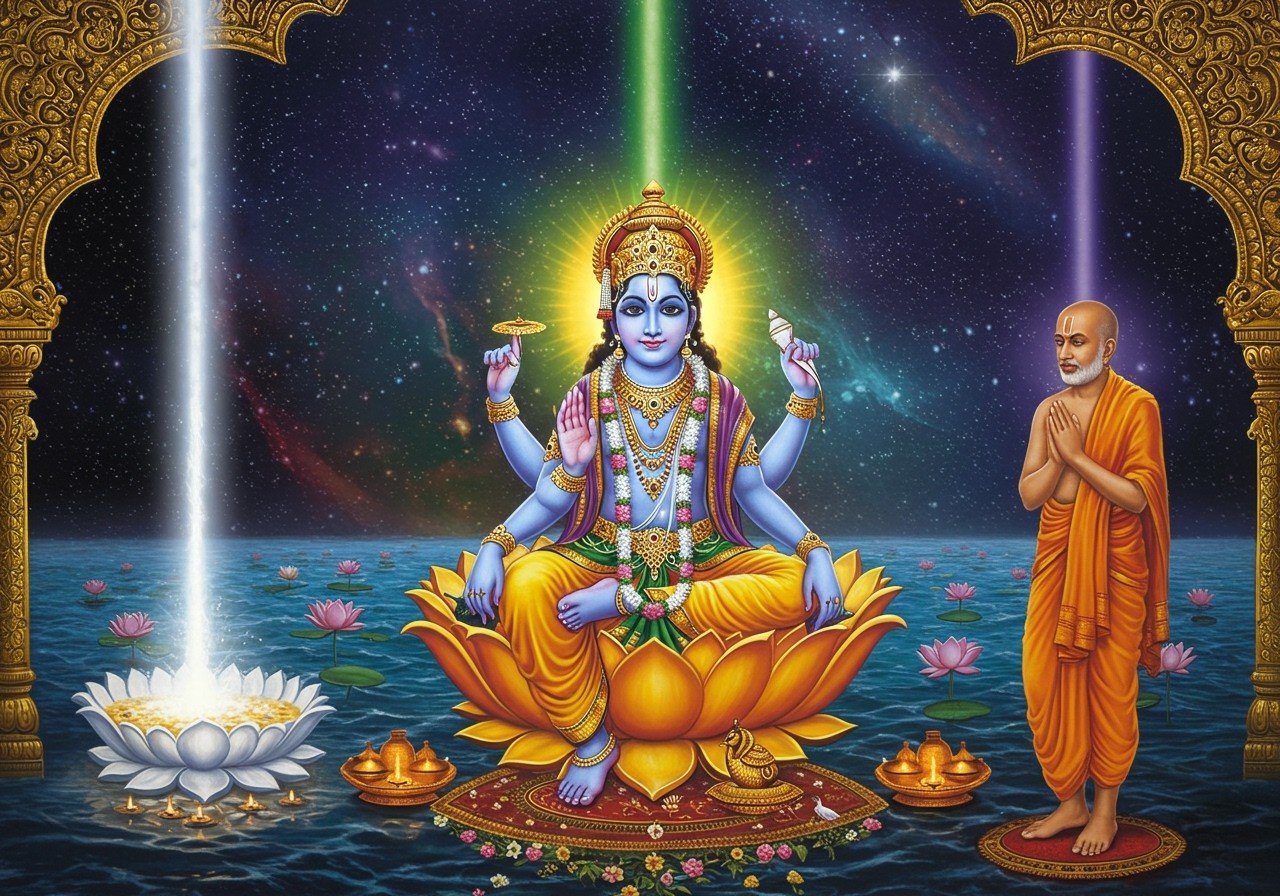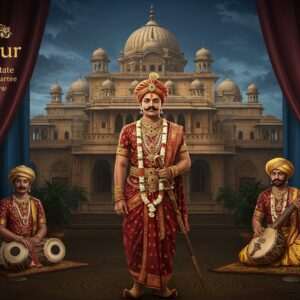
Vishishtadvaita, meaning “qualified non-dualism,” is a captivating school of thought within the Vedanta tradition of Hindu philosophy. It beautifully merges the concepts of unity and diversity, appealing to those who value cultural heritage. Let’s delve into its rich tapestry and understand its profound impact on spiritual life.
Core Tenets of Vishishtadvaita
- Qualified Non-Dualism: This philosophy masterfully blends the concept of oneness with the reality of individual distinctions. It harmonizes with the Upanishads’ teachings on unity while acknowledging the existence of unique entities within that overarching oneness. It suggests that the universe and individual souls are both distinct and inseparable from Brahman.
- Brahman as Supreme Reality: Vishishtadvaita posits Brahman as the ultimate reality, not merely an impersonal absolute. It is seen as a personal God imbued with attributes, often identified as Vishnu or Narayana. Brahman embodies consciousness, bliss, and omnipresence, possessing infinite auspicious qualities. This personal aspect of Brahman allows for a deeper connection with the divine.
- Reality of the World: Unlike some philosophies that perceive the world as an illusion, Vishishtadvaita affirms the reality of the material world. It views the world as a genuine manifestation of Brahman, a dynamic stage for the spiritual evolution of individual souls. This perspective encourages engagement with the world as a sacred space.
- Distinct yet Inseparable Jivas: Individual souls, known as jivas, are considered eternal and distinct from Brahman, yet eternally dependent on Brahman for their existence and well-being. Even after achieving liberation (moksha), jivas retain their distinct individuality. This emphasizes the unique nature of each soul’s journey.
Key Principles: Tattva, Hita, Purushartha
- Tattva (Knowledge of Three Realities): This involves a deep understanding of the three fundamental realities: jiva (individual souls), ajiva (the non-sentient universe), and Ishvara (the Supreme Self, often identified as Vishnu-Narayana or Parabrahman). This knowledge forms the basis for spiritual understanding.
- Hita (Means of Realization): Realization is achieved through bhakti (devotion) and prapatti (self-surrender). These practices are seen as essential for spiritual progress and connecting with the divine. They cultivate a deep and personal relationship with Brahman.
- Purushartha (Goal to be Attained): The ultimate goal in Vishishtadvaita is moksha, liberation from the cycle of birth and death and the limitations of worldly existence. This liberation is not simply an escape from the world but a transformation of one’s relationship with it.
Relationship Between Brahman, Jivas, and Jagat
Jivas (individual beings) and jagat (the material universe) are real and distinct from Brahman but inseparable from Him. They exist within Brahman and are sustained by Brahman’s power.
- Sarira-Sariri Concept: Brahman is the sariri (possessor of the body), while the jivas and jagat together form the sarira (body) of Brahman. This analogy illustrates the intimate relationship between the divine and creation.
Brahman is the inner controller (antaryamin) of all beings and the material world, guiding and sustaining all of existence.
Key Concepts
- Bhakti: Devotion to Vishnu, often depicted with multiple arms holding symbolic objects, is essential for liberation. True surrender and love for Vishnu are crucial for the upliftment of the individual self. This devotion fosters a deep connection with the divine.
- Moksha: The ultimate goal is liberation (moksha), where the individual soul attains eternal service to Vishnu in the spiritual realm. This liberation marks the culmination of spiritual growth and the realization of one’s true nature. It represents a state of eternal bliss and communion with the divine.
- Three Essential Qualities of Brahman: Eternal existence (Sat), consciousness (Cit), and infinite bliss (Ananda) are the three fundamental qualities of Brahman. These qualities represent the very essence of the divine and serve as a focus for contemplation and devotion. They reflect the boundless nature of Brahman.
Differences from Advaita Vedanta
- Nature of Brahman: Vishishtadvaita views Brahman as a personal deity with attributes, while Advaita Vedanta considers Brahman to be without attributes (Nirguna Brahman). This difference in understanding the nature of Brahman leads to distinct paths of spiritual practice.
- Reality of the World: Vishishtadvaita affirms the reality of the material world as a manifestation of Brahman, while Advaita Vedanta considers the world to be Maya, an illusion. These contrasting views shape how followers of each school interact with the world.
- Nature of Jivas: Vishishtadvaita considers jivas to be eternally distinct entities, part of Brahman yet retaining their individuality. Advaita Vedanta, however, sees jivas as temporary manifestations of Brahman that ultimately merge back into the absolute. This fundamental difference impacts the understanding of individual identity and the nature of liberation.
Ramanujacharya’s Role (1017-1137 CE)
- Systematizing Vishishtadvaita: Ramanujacharya, a revered philosopher and theologian, played a crucial role in systematizing Vishishtadvaita. His commentaries on key scriptures provided a structured framework for this school of thought. He clarified and organized the core principles of Vishishtadvaita, making them accessible to a wider audience.
- Reconciling Scriptures and Tradition: Ramanujacharya harmonized the Prasthanatrayi (the three principal texts of Vedanta) with the theism and philosophy of the Vaishnava Alvars, South Indian poet-saints. This reconciliation integrated devotional practices with philosophical understanding. He demonstrated the compatibility of scriptural authority with the experiential wisdom of the saints.
- Emphasis on Bhakti: Ramanujacharya emphasized bhakti (devotion) to Vishnu as a means to spiritual liberation. He highlighted the importance of a personal relationship with the divine as a path to moksha. His teachings inspired a deep devotional tradition within Hinduism.
Significance of Vishishtadvaita
- Integration of Knowledge and Devotion: Vishishtadvaita seamlessly integrates jnana (knowledge) and bhakti (devotion) by providing a rational basis for devotion. It shows that intellectual understanding and heartfelt devotion can complement and enhance each other. It offers a balanced path that incorporates both head and heart. Explore our range of Puja Samagri to support your devotional practices.
- Comprehensible View of Brahman: It offers a more comprehensible view of Brahman by presenting the divine as possessing infinite existence, consciousness, and bliss, qualities that resonate with human experience. This allows for a more personal and relatable connection with the ultimate reality. It provides a framework for understanding the divine in a way that is meaningful and accessible. Discover beautiful Lord Vishnu idols at Poojn.in to enhance your devotion.
- Explanation of Relationships: It explains the relationship between the individual self (jiva), the supreme self (Brahman), and worldly phenomena (jagat) in a clear and coherent manner. It clarifies the interconnectedness of all things while maintaining the distinction between the individual and the divine. This understanding provides a foundation for ethical living and spiritual growth. Deepen your understanding of Hindu philosophy with our insightful articles: Hindu Philosophy Explained and Hindu Symbols Explained.
- Emphasis on Spiritual Evolution: It emphasizes spiritual evolution through devotion and surrender, offering a path of personal transformation and growth. It encourages individuals to cultivate love, compassion, and a sense of unity with all beings. It provides practical guidance for living a meaningful and fulfilling life. Enhance your spiritual practice with authentic Dashakarma items available at Poojn.in.
This philosophy continues to inspire those seeking spiritual depth and meaning while honoring tradition. Learn more about the global reach of Hinduism and its diverse traditions in our informative blog post: Hinduism’s Global Reach. Discover the profound concepts of Dharma and Karma in Hinduism by reading our insightful blog: Dharma and Karma in Hinduism Explained. With its balanced emphasis on devotion and intellectual inquiry, Vishishtadvaita remains a significant part of spiritual discourse today. We invite you to explore our wide range of Puja items and low-value products to enhance your spiritual journey.


